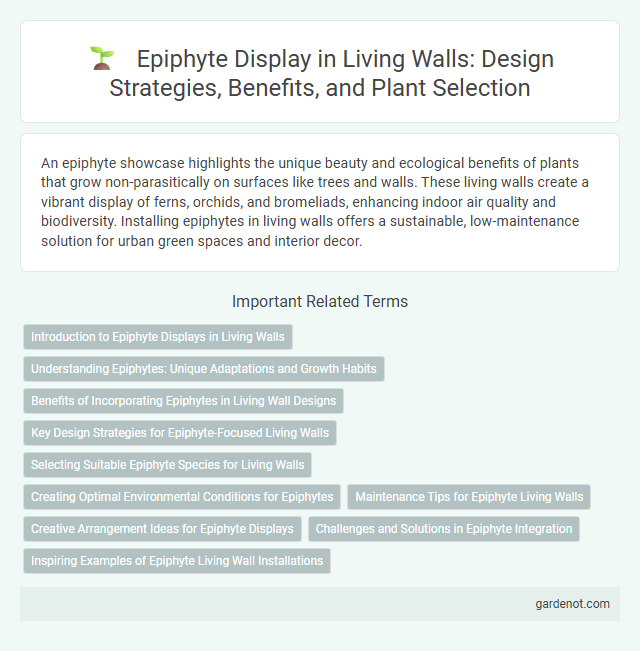An epiphyte showcase highlights the unique beauty and ecological benefits of plants that grow non-parasitically on surfaces like trees and walls. These living walls create a vibrant display of ferns, orchids, and bromeliads, enhancing indoor air quality and biodiversity. Installing epiphytes in living walls offers a sustainable, low-maintenance solution for urban green spaces and interior decor.
Introduction to Epiphyte Displays in Living Walls
Epiphyte displays in living walls highlight plants that grow on other surfaces without soil, utilizing natural air moisture and nutrients. This sustainable design approach enhances biodiversity and air purification while creating striking vertical gardens suitable for indoor and outdoor environments. Key epiphytic species include orchids, ferns, and bromeliads, which thrive in well-ventilated, humid conditions, making them ideal for dynamic green wall installations.
Understanding Epiphytes: Unique Adaptations and Growth Habits
Epiphytes, commonly featured in living walls, thrive without soil by anchoring onto host surfaces and absorbing moisture and nutrients from the air. Their unique adaptations include specialized root systems and water-storing tissues that enable survival in diverse environments. Understanding epiphytes' growth habits enhances the design of sustainable, low-maintenance vertical gardens that promote biodiversity and air purification.
Benefits of Incorporating Epiphytes in Living Wall Designs
Epiphytes enhance living wall designs by improving air quality through natural filtration of pollutants and increasing biodiversity in urban environments. Their lightweight, soil-free growth reduces structural stress on walls while providing unique textural and visual appeal that supports sustainable indoor and outdoor green spaces. Incorporating epiphytes promotes energy efficiency by aiding in temperature regulation and moisture retention in microclimates created by living walls.
Key Design Strategies for Epiphyte-Focused Living Walls
Epiphyte-focused living walls emphasize minimal substrate use and optimized air circulation to mimic natural growing conditions, promoting healthy root aeration and moisture retention. Strategic placement of mosses, ferns, and orchids maximizes light exposure and humidity, enhancing plant vitality and longevity within the vertical garden. Integrating drip irrigation systems with precise humidity control ensures consistent hydration without waterlogging, supporting the epiphytes' unique moisture requirements.
Selecting Suitable Epiphyte Species for Living Walls
Selecting suitable epiphyte species for living walls requires evaluating factors such as light tolerance, humidity preferences, and growth habits to ensure optimal survival and aesthetics. Species like Tillandsia, orchids, and certain ferns thrive in vertical environments due to their minimal soil requirements and adaptability to air moisture. Choosing epiphytes with resilient root systems and slow growth rates promotes longevity and reduces maintenance in living wall installations.
Creating Optimal Environmental Conditions for Epiphytes
Epiphytes thrive in living walls by requiring precise humidity levels, indirect light, and consistent air circulation that mimic their natural habitats. Using specialized substrates such as sphagnum moss or coconut coir enhances moisture retention while preventing root rot. Monitoring temperature ranges between 15-25degC and maintaining relative humidity at 60-80% ensures healthy growth and vibrant foliage.
Maintenance Tips for Epiphyte Living Walls
Epiphyte living walls require consistent moisture monitoring to prevent desiccation while avoiding waterlogging, which can lead to root rot. Incorporating organic mulch or sphagnum moss around the root zone enhances humidity retention and supports healthy epiphyte growth. Regular inspection for pests and removal of dead or yellowing leaves ensures the living wall remains vibrant and disease-free.
Creative Arrangement Ideas for Epiphyte Displays
Epiphyte showcase designs elevate living walls by integrating mosses, ferns, and orchids in layered, vertical patterns that maximize air circulation and light exposure. Utilizing driftwood, wire grids, or reclaimed wood panels as mounting bases emphasizes natural textures and enhances plant health. Strategic spacing and varied plant heights create dynamic, three-dimensional displays that highlight the unique growth habits of epiphytic species.
Challenges and Solutions in Epiphyte Integration
Integrating epiphytes into living walls presents challenges such as securing adequate humidity, ensuring air circulation, and preventing nutrient deficiencies due to their non-soil growth habits. Solutions involve utilizing specialized mounting techniques, implementing misting systems to maintain moisture levels, and selecting epiphyte species with complementary environmental needs. Advanced sensor technologies can monitor microclimate conditions, optimizing growth environments for sustained health and visual appeal.
Inspiring Examples of Epiphyte Living Wall Installations
Epiphyte living wall installations transform urban spaces into vibrant ecosystems by showcasing air plants, orchids, and bromeliads that thrive without soil. Notable examples include Singapore's Changi Airport, where epiphytes adorn vertical gardens, enhancing air quality and aesthetics. These installations inspire sustainable design by integrating biodiversity, environmental benefits, and artistic expression in compact, living architecture.
Epiphyte showcase Infographic

 gardenot.com
gardenot.com